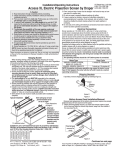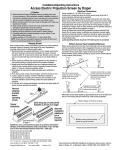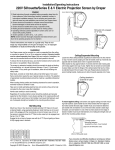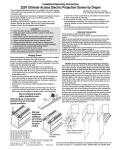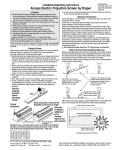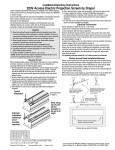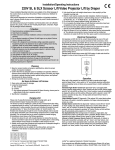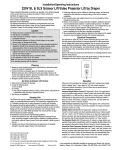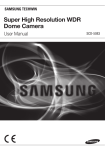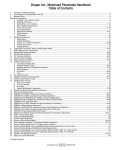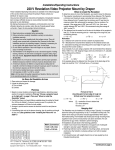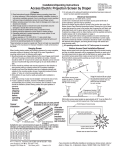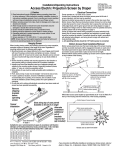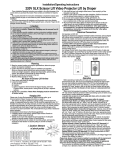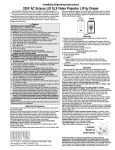Download Draper VIC-12 Operating instructions
Transcript
Installation/Operating Instructions Access XL 220V Electric Projection Screen by Draper These Installation/Operating Instructions are available in the official language of the country where you purchase the product. Please contact your distributor to request a copy. Vous pourriez demander les instructions d’installation et d’opération traduises dans la langue officielle du pays ou vous achetez le produit. Veuillez demander à votre distributeur. Die Gebrauchsanweisung für Installation und Konstruktion sind in der offiziellen Sprache des Landes, indem Sie das Produkt gekauft haben, vorhanden. Fragen Sie die jeweilige Verkaufs-Abteilung. Caution ① Read instructions through completely before proceeding. ② Follow instructions carefully. Installation contrary to instructions invalidates warranty. ③ Pick up screen case from ends only. Picking case up at other points will damage case and may damage fabric. ④ To insure a safe installation, the entire weight of the unit MUST BE supported by outermost ceiling mounting brackets (those on ends). Don't use intermediate brackets to lift or support the weight of the screen. ⑤ To eliminate the possibility of the case warping, outermost ceiling mounting brackets (those on ends) must be located centered above the interior roller mounting brackets (+/-102mm). ⑥ Entire bottom of screen case should be unobstructed to permit access to bottom panel for making electrical connections or servicing. ⑦ Screen should be installed level (using a carpenter’s level). ⑧ Operating switch(es) packed separately in screen carton. Do not discard with packing material. ⑨ An appropriate disconnect device shall be provided as part of the building installation. ⑩ Screen operates on 220V, 50 Hz., 1ph. with max 2.1 amp draw. NOTE: Screen has been thoroughly inspected and tested at factory and found to be operating properly prior to shipment. Hanging Screen When locating viewing surface and checking clearance for screen operation, remember surface is centered in the length of the case. Regardless of mounting method used, the following points apply: ① Engage each ceiling mounting bracket with top of housing as shown below and tighten nuts. The outer two brackets should be centered above the location of the interior roller brackets (+/-102mm). The remaining two brackets should be equally spaced between the outermost brackets. ② Screen should be lifted into position only by the outermost ceiling mounting brackets (those on ends). Keep case level by lifting each end simultaneously to prevent surface damage. Never attempt to lift screen along its length. ③ The entire weight of the unit MUST BE supported by the outermost mounting brackets to provide a secure installation (those on ends). Do not use intermediate brackets to lift or support the weight of the screen. ④ Screen should be positively and securely supported so that vibration or even abusive pulling on viewing surface will not weaken installation. ⑤ Installer must insure that fasteners used are of adequate strength and suitable for the mounting surface chosen. Installer must also insure that Typical Installation Slots along top of case permit brackets to be set at an angle Case dimensions on page 3. Alternate Installation (additional set of brackets required but not included). Two intermediate brackets must be spaced evenly from ends. 7 /8" electrical cutout Suitable for use in environmental air space in accordance with Section 300-22(c) of the National Electrical Code, and Sections 2-128, 12-010(3) and 12-100 of the Canadian Electrical Code, Part 1, CSA C22.1. US Patent Nos. 6,137,629; 6,421,175; 6,532,109; 6,816,308; 7,559,707 ceiling structure is of adequate strength. Supporting hardware (chains, cables, 9.5mm rods, etc.) must be essentially vertical. ⑥ Entire bottom of case must be readily accessible after installation is complete. ⑦ Front, back and top of case must be straight—not forced to warp or bow (see note 5 in caution box). ⑧ Do not use case to support adjacent sections of ceiling. ⑨ If case is painted on location, removal of roller/fabric assembly is recommended prior to painting. If not removed, slot on bottom of case should be shielded to protect viewing surface from paint splatters or overspray. ⑩ Do not seal unit in ceiling until electrical connections have been made and screen has been operated successfully. Electrical Connections Screen operates on 220V, 50 Hz., 1ph with max 2.1 amp current draw. Junction box is located just above the bottom access panel at left end of screen (standard, right end may be specified). Remove the bottom access panel for access to the junction box cover. (See Bottom Access Panel Removal instructions below.) Remove four (4) hex head screws that secure the cover to the junction box to expose the black, brown and blue pigtail leads and the green/yellow ground wire per wiring diagram on page 4. If optional low voltage control or video interface control is specified and factory installed, please refer to wiring diagrams on page 5. Screen is shipped with internal wiring complete and control switch (es) fully boxed. Wire to connect screen to switch (es) and switch (es) to power supply should be furnished by installer. Connections must be made in accordance with attached wiring diagram, and wiring must comply with national and local electrical codes. All operating switches should be “off” before power is connected. Motor Type Duty Cycle 506S2PA, 510S2PA, 515S2PA, 1 minute on, 3 minutes off 506S2 ILT2, 515S2 ILT2 525A2PA, 535A2PA, 535A2 ILT2 1 minute on, 10 minutes off NOTE: Excessive continuous operation may cause the motor to over heat. If this happens the motor will shut off until it cools to a normal operating temperature. Shipping Brackets If provided, remove shipping brackets by following Figure 2. Dowel Shipping Bracket Series V Figure 2 Bottom Access Panel Installation/Removal Removal and replacement of the bottom closure panel requires two people positioned about 152cm from each end of the panel. ① Before removing bottom closure, you must first remove screws at each end of case and slide the closure clips inward, away from the outside of the case (see Fig. 3). Case Front of case removed for clarity ® Closure Figure 3 Continued on next page Copyright © 2012 Draper Inc. Form AccessXL220_Inst12 Printed in U.S.A If you encounter any difficulties installing or servicing your Access XL screen, call your dealer or Draper, Inc., in Spiceland, Indiana, 765/987-7999 or fax 765/987-7142. Access XL 220 Volt Instructions by Draper ② Disengage closure from extrusion inside the case. Rotate closure as shown in Fig. 4 and remove, holding it so the closure remains in this position and does not bow before placing it on a flat surface. OR page 2 of 5 ⑤ Replace the eight Nylon Washers into the idler end of the roller assembly. ⑥ Loosen the carriage bolts which attach the flange-mounted bearing to the idler end bracket just enough to allow the bushing some limited movement, which will help when installing the roller assembly. ⑦ Rotate the bracket into the mounting channel located in the case top (when mounting the roller assembly into the case). Both the bracket flange and set screw collar side of the bearing must point toward the gudgeon assembly. ⑧ Raise the roller/fabric assembly up into the screen housing and engage the head of the motor completely into the motor mounting bracket, making sure the snap ring engages with the motor and that the limit switch adjusting knobs are visible from the bottom of the screen housing (see Fig. 6). Please note: Maximum torque for tightening screw is 6.77 Nm. Figure 4 Bottom flange of Access housing Caution: When placing the roller assembly into the case, be sure motor is fully re-seated in the bracket, and secure it carefully with the motor retaining spring and screw. Limit adjustment screws should be facing down to allow access to them. Figure 6 Bottom access panel pushup points for panel removal Caution: Beware of pinch points at ends of closure Access XL case as seen from below Accessory Access ACXLE & ACXLV Roller Installation Please note: When ordering a motor with built-in Low Voltage Controller, if the case ships separate from the "guts," the case includes the 762cm cable and special low voltage switch. ① Remove the bottom access panel (see "Bottom Access Panel Installation/ Removal" section above). ② The motor end mounting bracket has a metal bracket with snap ring for accepting motor head. The idler end mounting bracket has spherical ball bearings for accepting the idler pin. Both brackets have four set screws that will be used to tighten the brackets in place inside the case. Back out the four set screws in bracket until they are flush with top side of bracket, then remove the roller assembly from the shipping brackets, placing the roller assembly on a flat, clean surface (see Fig. 5). Caution: Due to the weight of the roller assembly, this step requires at least two people to perform safely. ⑨ While supporting the idler end of the roller, slide the idler end mounting bracket toward the roller. Slide the bearing over the end of the shaft. Caution: Do not allow bracket to rotate and fall out of channel! Align the bracket into the housing and tighten all four of the set screws. Lock the roller assembly into place on the mounting bracket with the fender washer, spring lock washer and machine screw (see Fig. 7). Idler End Roller Bracket 8 Nylon Washers Roller Gudgeon Assembly Setscrews Fender Washer Machine Screw Spring Lock Washer Figure 7 Bearing Collar Carriage Bolts ⑩ Re-tighten the carriage bolts in the Idler-end Bracket Assembly so that the flange-mounted bearing is locked in place (see Fig. 5). ⑪ Tighten the two set screws in the bearing collar. ⑫ Connect electrical plug from motor to mating socket on junction box. ⑬ Reinstall the bottom access panel as previously described (see Figs 3 & 4). Shipping Brackets Carriage Bolt Motor End (Series V shown) Setscrews Idler End (Series E shown) Figure 5 Please Note: Do not lose the snap ring and screw from the motorized end, or the eight nylon washers, spring lock washer, fender washer and machine screw from the idler end. They are required for re-attaching the roller assembly to the brackets inside the case. ③ To engage the motor end bracket flange above the two channels in the top of the screen housing, rotate the bracket approximately 45° counterclockwise to allow the top surface of the motor bracket to rest flat against the top inside of the housing. Rotating the bracket clockwise until it is engaged with the mounting channel, slide it along the length of the housing against the electrical junction box. Note: Set screw collar side of the bracket must point toward the center of the case. Caution: Do not allow the bracket to rotate and fall out of the channel. ④ Tighten all four set screws. www.draperinc.com Motorized Roller/Fabric Removal Reverse the instructions above “Motorized Roller/Fabric Installation” for removal of the unit. Operation When screen is first operated, be cautious! Cycle unit down and up several times to confirm satisfactory operation. 220V SINGLE STATION CONTROL—3-position UP-OFF-DOWN switch permits operation to be stopped at any point. Factory adjusted limit switches automatically stop screen when fully down or fully up. 220V MULTIPLE STATION CONTROL—(Not CE Approved) Switches are similar in appearance to 220V Single Station Control. Screen stops when switch is released and may be restarted in either direction. Factory adjusted limit switches stop screen automatically when fully up or fully down. 24V CONTROL—Three-button UP-STOP-DOWN switches stop at any point desired, operate in any sequence. Factory adjusted limit switches automatically stop screen when fully up or fully down. Installer should incorporate an all-pole disconnect in the fixed wiring. 220V & 12V VIDEO INTERFACE CONTROL—(Not CE Approved) Allows (765) 987-7999 Access XL 220 Volt Instructions by Draper screen to be controlled by a trigger signal—when the signal comes on, the screen descends automatically. Two versions: Model VIC220 integrates screen operation with a Draper video projector lift or a video projector or tuner with a 220V switched outlet. Model VIC12 interfaces with a 12V switched outlet. Both available with an override switch (VIC–OS), permitting independent operation. VIC–OS not available with factory installed VIC220 & VIC12. KEY OPERATED SWITCHING—(Not CE Approved) Two kinds of keyoperated switches are optionally available with this unit. ① The key-operated power supply switch controls power to the screen and switches. When it is “off”, the switches will not operate screen. Key may be removed from the switch in either “on” or “off” position. ② A three-position key switch permits the screen to be operated directly by key. In this case, the screen’s operator must always have a key. RS232/ETHERNET—Serial communication and network communication optionally available with wall switches, RF or IR remote. Tab-Tension Adjustment Procedure for Access XL/Series V Draper’s Tab-Tensioning System is factory-set; under normal circumstances field adjustment is not required. If you notice wrinkles, waves or other indications that tensioning cables need adjusting, follow these steps: ① Determine which side requires adjustment. ② Secure dowel with one hand. Tensioning Caution: Don't touch or bend viewing surface. Cable ③ Use Phillips-head screwdriver to push in spring-loaded adjustment screw. Slowly Dowel Adjustment turn clockwise to tighten tension or Screw counterclockwise to loosen tension. The screw adjusts in ¼ turn increments. Adjust only one increment (¼ turn) at a time. ④ If problem is not corrected, leave screen in position for 24 hours to allow surface material to stretch into position. ⑤ If problem still is not corrected, repeat steps 2 and 3. Limit Adjustments (Standard Motor) Please Note: Screen limits are factory set for optimum performance of the screen. A procedure is outlined below for minor tweaks, but any adjustment of these limits may negatively affect the flatness of the screen surface and could also void the warranty. Please check with Draper prior to resetting screen limits. CAUTION: Always be prepared to shut screen off manually when new adjustment is being tested. Screen may be severely damaged if viewing surface is allowed to run too far up or too far down. CAUTION: Be sure all switches are in “off” position before adjusting limit switches. The motor limit screws are normally located on the audience left of screen roller. **Please Note: If the Access XL is “Right Hand Motor”, WHITE/DOWN and YELLOW/UP limit screws are reversed. See graphic below. "Down" Limit Adjustment To Reduce Screen Drop ① Raise screen surface about 30cm above desired setting and turn off. ② Turn the WHITE/DOWN limit screw clockwise (three screw turns = ½ roller revolution). ③ Test by running screen down and repeat steps 1 and 2 until desired position is reached. To Increase Screen Drop ① Run screen to the down limit. ② With the down switch on, turn WHITE/DOWN limit screw counterclockwise (3 turns of screw equals ½ roller revolution) to increase drop. Screen will drop automatically for each turn. ③ Test by running screen up about 30cm and back down to new down limit. ④ Repeat steps 2 and 3 until desired position is reached. "Up" Limit Adjustment Screen is Running Too Far Up ① Lower screen surface about 1' below desired setting and turn off. ② Turn YELLOW/UP limit screw clockwise (3 screw turns = ½ roller revolution). ③ Test by running screen up. ④ Repeat steps 1 through 3 until desired position is reached. Screen Needs to Run Up More ① Run screen down about 30cm and turn off. ② With the up switch on, turn the YELLOW/UP limit screw counterclockwise (3 turns of screw equals ½ roller revolution). Screen will drop automatically for each turn. ③ Repeat steps 1 and 2 until desired position is reached. CAUTION: Do NOT allow the dowel to wrap up over the roller when the screen is running up! This could damage the screen. www.draperinc.com page 3 of 5 Right Hand Motor Location Left Hand Motor Location Audience Side Audience Side (Fabric from back of roller) (Fabric over front of roller) Limit Adjustments (Built-in Low Voltage Motors) Please Note: Screen limits are factory set for optimum performance of the screen. A procedure is outlined below for minor tweaks, but any adjustment of these limits may negatively affect the flatness of the screen surface and could also void the warranty. Please check with Draper prior to resetting screen limits. CAUTION: Always be prepared to shut screen off manually when new adjustment is being tested. Screen may be severely damaged if viewing surface is allowed to run too far up or too far down. CAUTION: Be sure all switches are in “off” position before adjusting limit switches. Please note: When ordering a motor with built-in Low Voltage Controller, if the case ships separate from the "guts," the case includes the 25' cable and special low voltage switch. ① Connect the ILT switch to the motor via the terminal blocks, or via the modular port using four conductor modular cable. When using modular cable, the cable connectors MUST NOT be crimped in reverse, as with standard telephone cable. (For Dry Contacts Wiring Diagram, see page 4.) ② Set the slide switch to the lower position. Press and hold the DOWN button on the switch to move the viewing surface to the desired lower limit. If the screen moves in the opposite direction, release the DOWN button and press and hold down the STOP button for four seconds. This will reverse the operation of the UP and DOWN switches. ③ Move slider switch into center position. Wait a couple of seconds. Please Note: If you move the slider switch from down to up in one motion it sets the two limits in the same postion. ④ Set the slide switch to the higher position. Move the viewing surface to the desired upper limit by pressing and holding the UP button on the wall switch. ⑤ Return the slide switch to the center position to return to normal operation. ⑥ To set the viewing surface to an alternate format position, move the viewing surface to the desired position and press the STOP button. Press and hold the STOP button for at least three seconds to record the position. Please Note: Pressing and releasing the UP button on the switch will move the screen to its upper limit. Pressing and releasing the DOWN button will move the screen to its lower limit. While the motor is in motion, pressing the STOP button for less than two seconds will stop the viewing surface at its present position. POT S Once the motor is stopped, pressing the STOP button will move the viewing surface to its alternate format position. Pressing and holding the STOP button, when the motor is at rest or in motion, for at least three seconds will record a new alternate format position. C + o 5V m DC m o n UD p o w n P PO OT TS S POSITION Back View FUNCTION DOWN Set LOWER limit UP Set UPPER limit CENTER Normal Operation To Motor with Built-In Low Voltage Slide Switch (765) 987-7999 To Motor with Built-In Low Voltage Access XL 220 Volt Instructions by Draper page 4 of 5 Case Dimensions Series E Case Length = Fabric width + 321mm Series V Case Length = Varies Centered over roller bracket (+/-102mm) Evenly Spaced Evenly Spaced Evenly Spaced 229mm 197mm 25.4 mm 265 254 mm mm L 216mm 241mm Series V-L=varies Series E-L=160mm Ceiling Mounting Bracket Locations and Configurations Typical Installation: Two outermost ceiling mounting brackets (on the ends) must be centered over the interior roller brackets (+/102mm). Two intermediate brackets should be spaced evenly from the outermost ceiling mounting brackets. Alternate Installation: Two outermost ceiling mounting brackets (on the ends) are centered over the interior roller brackets (+/-102mm), parallel to the case. The two intermediate brackets should be placed in the typical perpendicular configuration, and spaced evenly from the outermost ceiling mounting brackets. Wiring Diagrams—220V Motor with Built-in Low Voltage Controller Wiring Diagrams—220V Motor Please Note: Do not wire motors in parallel. Single Station Control Junction box at left end of screen CE Approved Junction box at left end of screen Multiple Station Control Not CE Approved Single Low Voltage Control Multiple Low Voltage Controls Internal Screen Wiring Blue-220v (Common) Brown-220v (Down) Black-220v (Up) Internal Screen Wiring Blue-220v (Common) Brown-220v (Down) Black-220v (Up) Green/Yellow (Motor Ground) Green/Yellow (Motor Ground) Cap off with wire nut & tape Dashed wiring by electrician Wall Switch, RF or IR Receiver, or integrated control system Black Blue Neutral Red Black L1 Blue Red To 220V Line To 220V Line Wall Switches, RF or IR Receivers, or integrated control systems Black Hot 220v, 50 Hz. Neutral Dashed wiring by installer Data Cables Blue Red Control switch Dashed wiring by electrician Data Cable Dashed wiring by installer 220v, 50 Hz. www.draperinc.com *These wiring diagrams are for Access XL screens with motor on audience left (standard), and fabric unrolling from the back of the roller (standard). (765) 987-7999 Access XL 220 Volt Instructions by Draper page 5 of 5 ILT Switch-to-Motor—Dry Contacts or Data Cable connection Please Note: This Splitter/ Jack is located inside the junction box of your Access XL screen. Motor Data Cable plugged in here Back of wall switch. UD P O W N C 5V O M M O N Please Note: Although both Dry Contact and Data Cable connections are shown, you should only use one connection type per motor. Data Cables to switches or to additional motors can be plugged into any of the three open jacks. If this is a "Case First, Screen Later" installation, plug the motor cable into the jack indicated in the drawing. UP 5V COM DWN Two-Way Serial Communication (RS232) with MC1 Low Voltage and Wireless Control (LVC-III) Internal Screen Wiring Internal Screen Wiring White or Blue-Common Red-to Screen (directional) Black-to Screen (directional) Brown-Hot to AC Green/Yellow-Ground Program LED Low Voltage Wiring by others AC Wiring by electrician Fuse Dashed wiring by electrician Low voltage wiring by others Eye Port for IR Eye, RF Receiver or LED Wall Switch. For more than one of these, a splitter is required. 3 Button Wall Switch DOWN - Black COM - White UP - Red RS232 Data FROM Control System RS232 Data TO Control System Signal Ground & Manual Switch Common Manual Switch Down Manual Switch Up Location of key operated on-off switch if furnished Eye Port for IR Eye. For RF Receiver or LED Wall Switch, a Splitter and a Power Supply is required. Plug RF Receiver or LED Wall Switch and Power Supply into splitter, then run cable from Splitter to MC1 Eye Port. To AC Line MC1 White/Blue (Common) Red 110/Black 220 (Up) Black 110/Brown 220 (Down) Green/Yellow (Motor Ground) White or Blue-Common to screen & 110/220V AC Neutral Red-to screen (directional) Brown-to screen (directional) Yellow-to 110/220V AC-Hot Black-to 110/220V AC-Hot Green/Yellow (Ground) White/Blue (Common) Red 110/Black 220 (Up) Black 110/Brown 220 (Down) Green 110V/ Green/Yellow 220V (Motor Ground) Aux Port for connecting additional LVC-III modules (up to six total can be linkedconnect from Aux to Eye). To 110/220V Line STOP STOP Location of key operated on-off switch if furnished Control Switches 24v DC See separate Serial Communication-RS232 Instruction sheet for enabling RS232 with the MC1. Built-In VIC-12/VIC-6* Built-In VIC-220* 12 Volt (VIC-12) or 6 Volt (VIC-6) Relay 115 Volt Relay Ring Terminal on each Ground Wire with Star Washer screwed to Spine :: : : HSG. Cap HSG. Plug : : :: Green/ Yellow Black Brown Blie Ground #2 Up #1 Down Common 220 VAC Screen Motor Jacketed Motor Cable Blue Brown Black Wire soldered to terminal Wire connected with Quick Disconnect Black 3 1 Green/Yellow Jacketed Motor Cable Green/ Yellow 7 5 Blue Lead 220 VAC Screen Motor Black Lead HSG. Cap HSG. Plug Blue Blue Black Green/Yellow Brown (-) Orange (+) Black Brown 6 4 2 : : :: Brown 8 Ground #2 Up #1 Down Common : : :: Black Green/Yellow : : :: Green Yellow 14 13 9 :: : : 5 :: : : 1 :: : : : : :: Ring Terminal on ground wire riveted to J-Box with Star Washer :: : : Wire connected with Quick Disconnect *These wiring diagrams are for Access XL screens with motor on audience left (standard), and fabric unrolling from the back of the roller (standard). Mounting Bracket Dimensions 9.5 mm 35 mm 12.7 mm R 6.4 3.2 mm mm 38 mm 8 mm 4.8 mm 28.6 mm 6.4 mm R3.2 mm 4.8 mm 114 mm 8 mm 197 mm www.draperinc.com 32 mm 122.2 mm 228.6 mm (765) 987-7999 6.4 mm





